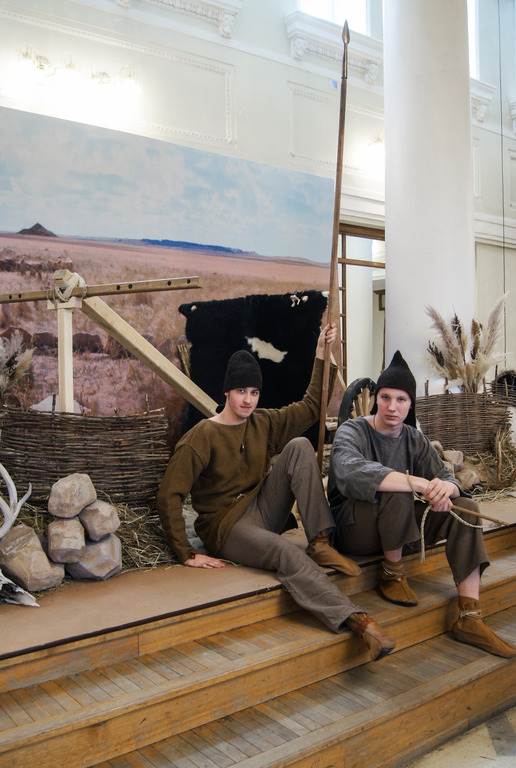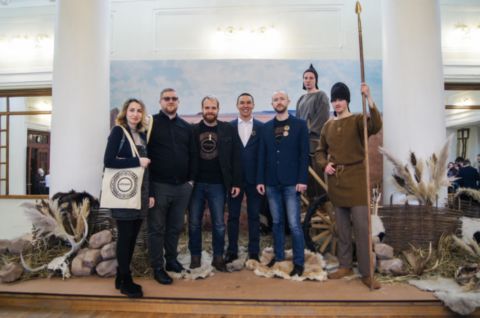History students of South Ural State University have taken part in the premiere screening of an Arkaim. The Chariot of Time popular-science documentary. It narrates about the earliest civilization of cattle herders and metallurgists that emerged in the South Ural region four thousand years ago. They created the so-called Sintashta culture.
The film is fascinating and in layman's terms explains the value of Arkaim and its influence on the world history. In particular, it narrates about an experiment on the reconstruction of the most ancient chariot known to archaeologists. Lecturer of the Department of Russian and International History, Head of the Laboratory of Experimental Archaeology at the SUSU Eurasian Studies Research and Education Centre Ivan Semyan acted as the project supervisor. Alumnus of the Department of Russian and International History and currently PhD in Anthropology at the University of Pittsburgh, USA, Igor Chechushkov acted as the project's scientific consultant. He also works as a Senior Research Fellow at the Eurasian Studies Research and Education Centre of the Institute of Media, Social Sciences and Humanities (IMSSH).
"More than 50 year sago, in the south of the Chelyabinsk Region, the Sintashta burial ground was found, which included chariot complexes. The idea to reconstruct a Sintashta chariot was conceived in 2008-2009 when together with archaeologist Gennady Zdanovich we created an exhibition model with its size at the scale of 1:4. In 2014, thanks to our colleagues from the Silver Unicorn historical reconstruction club we even managed to take a ride in a full-scale mock-up chariot! In 2017, Aleksandr Kislenko created a museum reconstruction of this Bronze Age vehicle without using any metal parts. In 2019-2020, jointly with archaeologists from Greece we managed to reconstruct a chariot driver's main weapon – the bow. And, finally, two years ago, we ventured upon a big-scale experiment on reconstructing a Sintashta chariot and harness," Ivan Semyan shared on the main stages of the project's progress. By today two chariot reconstructions have been created: one is exhibited in the Chelyabinsk airport named after I.V. Kurchatov, and another one has been presented at the film premiere and later it will be handed over to the Russia – My History museum to be added to the exhibition dedicated to the experiment and the Sintashta culture.

Initially, the SUSU scientists were planning on shooting a series of videos about the reconstruction process. But the collaboration with the 2020 Foundation for Social, Cultural and Educational Initiatives, established by the Chelyabinsk Region first lady Irina Texler, allowed the team to create an actual documentary that can be screened in cinemas or at film festivals, and which even has an international version. This scientific project by the Chelyabinsk archaeologists was supported by the grants from the Russian Foundation for Basic Research and from the Chelyabinsk Region Governor.
The IMSSH History students not only have taken part in the film premiere having dressed as ancient people, much to the delight of all the lovers of taking pictures, but also tried their hand in "acting". Bachelor's degree student from group СГ-406 Zakhar Matveev shared his impressions of this important event:
"Getting to know Ivan Semyan during my first year of studies at SUSU rocked my world – experimental archaeology has taken root in it once and for all. We began our co-creation: excavations, writing my course paper, collaborations in the Archeos association's projects, and much more. A was absolutely fascinated by the hypothesis of the Chelyabinsk archaeologists that the Sintashta chariot is the most ancient one in the world. This discovery proves that chariots began to spread to other countries namely from the territory of the Southern Urals, and this changes the attitude of the scientific community to the migrations of ancient people, their areal of dwelling, technologies, and so on. For example, the scientists entertain an idea of the high possibility of contacts between the representatives of the Sintashta and Mycenaean cultures thanks to the similar obsequial rites and certain household items. In particular, harness details similar to the Sintashta ones were found in Mycenae."

Zakhar shared that he participated in all the stages of the vehicle reconstruction (designing, production, assembly, testing, cosmetic treatment). The team tried to re-create the ancient technologies and preserve the authenticity: they steeped and bended the wood to construct the wheels, and they did not use nails. However, the towbar was cut using modern tools to save time and effort. What is interesting is that as a teacher Ivan Semyan engaged his students not only as "labour force", but first and foremost, for the purpose of sharing his knowledge and experience with them. But still, Zakhar confessed that the shooting of the chariot's test ride was the most memorable event. As well as, probably, the realization of the fact that they were making history.




